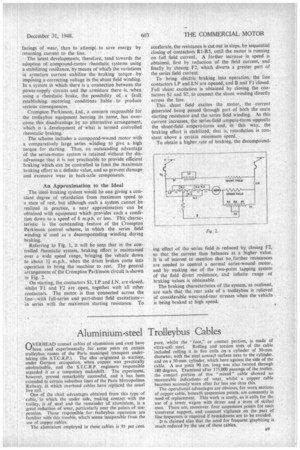Aluminium-steel Trolleybus Cables
Page 43

If you've noticed an error in this article please click here to report it so we can fix it.
OVERHEAD contact cables of aluminium and steel have been used experimentally for some years on certain trolleybus routes of the Paris municipal transport under
taking (the S.T.C.R.P.). The idea originated in wartime, under German occupation, when copper was practically unobtainable, and the S.I.C.R.P. engineers responsible regarded it as a temporary makeshift. The experiment, however, proved remarkably successful, and it has been extended to certain suburban lines of the Paris Metropolitan Railway, in which overhead cables have replaced the usual live rail.
One of the chief advantages obtained from this type of cable, in which the under side, making contact with the trolley, is of steel and the remainder of aluminium, is a great reduction of wear, particularly near the points of suspension. Those responsible for trolleybus operation are familiar with this trouble, which seems inseparable from the use of copper cables.
The aluminium employed in these cables is 95 per cent. pure, whilst the " foot," or contact portion, is made of extra-soft steel. Rolling and torsion tests of the cable included rolling it in five coils on a cylinder of 30-mm. diameter, with the steel contact surface next to the cylinder. and on a 50-mm. cylinder, which bore against the side of the cable. A test piece 90 cm. long was also twisted through 180 degrees. Examined after 175,000 passings of the trolley, the contact portion of this mixed " cable showed no measurable indications of wear, whilst a copper cable becomes seriously worn after far less use than this.
The operational advantages are obvious, for worn sections of copper cable, beneath suspension points, are constantly in need of replacement. This work is costly, as it calls for the use of a tower wagon with driver and a team of skilled men. There are, moreover, four suspension points for each transverse support, and constant vigilance on the part of line inspectors is required if breakdowns are to be avoided.
It is claimed also that the need for frequent graphiting is much reduced by the use of these cables.




























































































